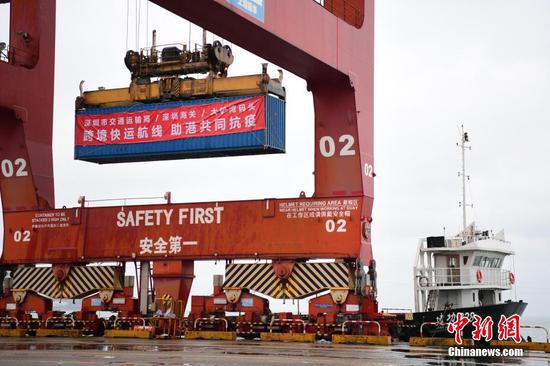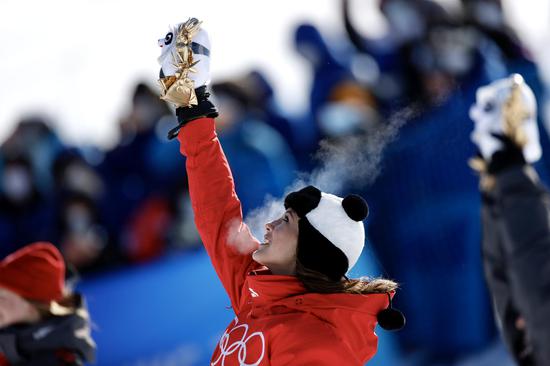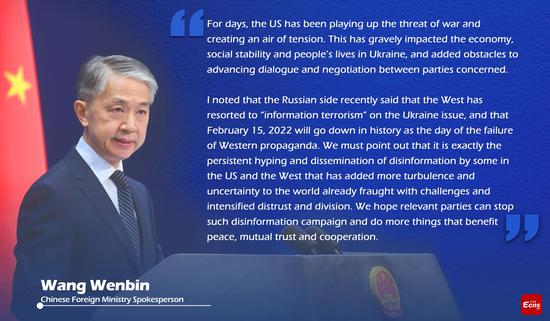
An employee fills up a vehicle at a gas station in Nanjing, Jiangsu province. (Photo by SU YANG/FOR CHINA DAILY)
While crude oil prices might reach $100 a barrel this year, the uptrend is expected to gradually ease in the long term with capacity recovery, continuous development of new energy and the recovery of U.S. shale oil production, analysts said on Tuesday.
Brent crude oil reached $96.78 per barrel on Monday, the highest price level since 2014. The immediate cause of the rise in oil prices is the geopolitical uncertainties caused by the tensions between Ukraine and Russia, which led to concerns over possible disruptions to Russia's energy supplies and the exacerbation of the existing shortage of oil and gas in the market.
Major Wall Street banks, including Bank of America, Goldman Sachs, JPMorgan and Morgan Stanley, expect Brent crude prices to touch, or even surpass, $100 a barrel as soon as this year.
Goldman Sachs said it expects Brent crude, the world benchmark, will hit $100 a barrel in the third quarter of this year, up from the bank's prior call for $80. Goldman Sachs foresees two things: Brent reaching $105 a barrel next year, up from a previous forecast of $85;and diminished appetite to invest in oil due to the industry transition to clean and green energy.
By summer, the bank expects oil inventories in advanced economies will sink to their lowest level since 2000.
Russell Hardy, chief executive of Vitol, a major trader in oil and petroleum products and owner of energy assets, was quoted by oilprice.com as saying that the 100 million barrel number is probably going to be exceeded this year and demand is going to surge in the second half.
The Organization of Petroleum Exporting Countries and its partners, led by Saudi Arabia and Russia, will meet on March 2 to decide on their April strategy. While some major oil importers have called on OPEC to pump faster, several of OPEC 's biggest producers want to continue with the current plan to add another 400,000 barrels a day of crude to the market in April.
OPEC refers to a group of nations that are allied with OPEC to cut production in order to boost oil prices beginning 2016. While not formal members of the cartel, the countries have worked with OPEC on production quotas through the COVID pandemic.
OPEC , led by Russia, includes Azerbaijan, Bahrain, Brunei, Kazakhstan, Malaysia, Mexico, Oman, South Sudan and Sudan.
Global energy demand has been getting out of the shadow of the pandemic with a clear rebound and will contribute to the coming rise in oil prices, said Luo Zuoxian, head of intelligence and research at the Sinopec Economics and Development Research Institute.
"The potential for economic recovery will largely drive oil and gas demand, while the oil and gas exploitation, exploration and downstream investment activities have been scaled down, which will also contribute to the anticipated rise in oil prices in the short term," Luo said.
"The oil price will gradually ease after some fluctuations as countries around the world have vowed to reduce the use of fossil fuels, which has also affected the willingness of some upstream oil and gas industry players to invest."
According to Luo, as China is highly dependent on oil imports, the rising oil prices will inflate costs for China's manufacturing industry.
In addition to geopolitical uncertainties, the rapid economic recovery has also been fueling the surge in oil prices, Luo said.
There has been a shortage of oil after the rapid recovery in demand, as much of the world's capacity was shut down and investment in the industry reduced due to the pandemic, and U.S. shale oil was also withdrawn from the market, he said.
Global oil inventory has been low due to certain geopolitical tensions and supply shortfalls related to OPEC .
BloombergNEF, an energy industry research provider, said it is bullish on oil prices for the week ahead.
"Positive developments around the Iran nuclear deal and the (possible) de-escalation of the Ukraine tensions have weighed on flat prices," said Tang Sisi, an analyst with BNEF.
"Crude and oil product inventories saw their deficit against the seasonal average swell to post-pandemic record highs due to product inventory drawdowns. Mobility indicators are showing a strong and steady pick-up in activity, while jet fuel demand is bouncing back following weeks of seasonal and virus headwinds."
As refineries head into the maintenance season, product inventories could continue to fall in the coming weeks, she said.
Ukraine's emergence as a potential flashpoint in the region around Russia could also cause a butterfly effect, sending commodity prices, including those of oil, gas, agricultural products, aluminum and nickel, spiraling higher as supply woes multiply, said Zhu Yi, a senior analyst with metals and mining at Bloomberg Intelligence, a market monitor.
"Surging commodity prices could drive up inflation, and gold prices may have upside potential due to the yellow metal's safe-haven character," Zhu said.
"Russia's wheat exports account for 16.9 percent of global output, followed by barley at 13.2 percent, gas at 5.3 percent, aluminum at 5.1 percent and oil at 4.7 percent. Agricultural products would probably be the hardest hit from a sanctions slap."


















































 京公网安备 11010202009201号
京公网安备 11010202009201号